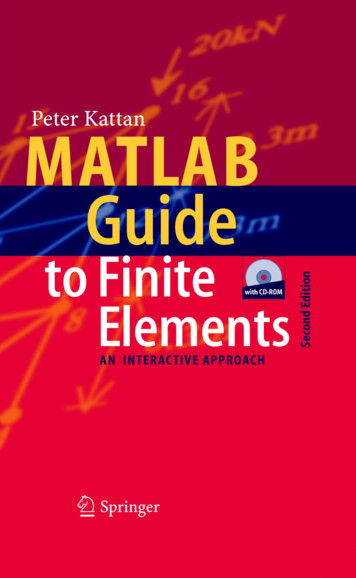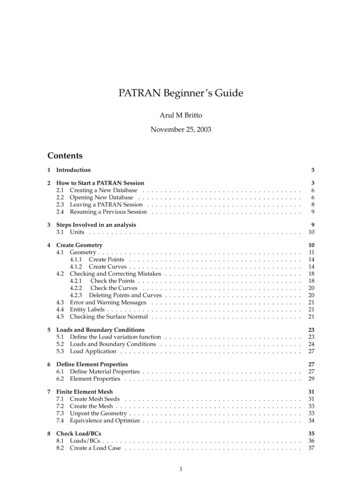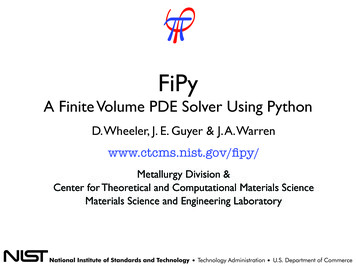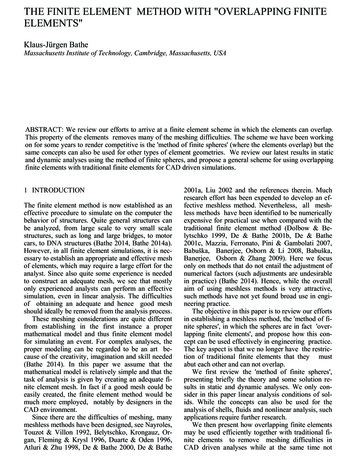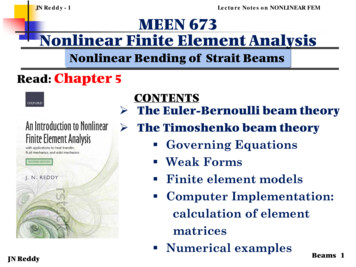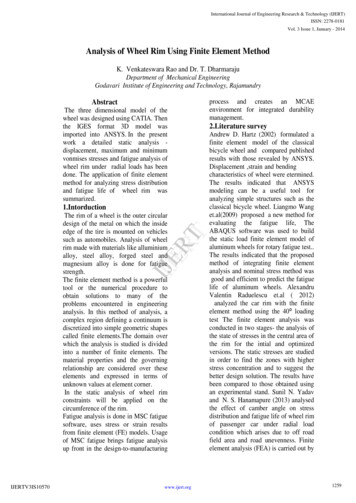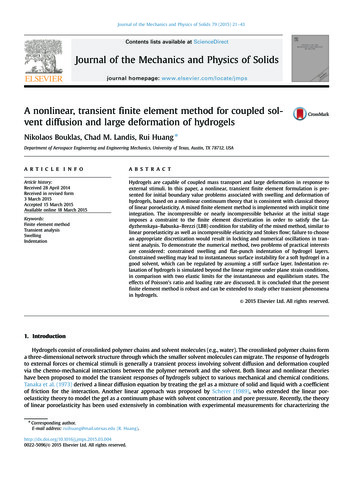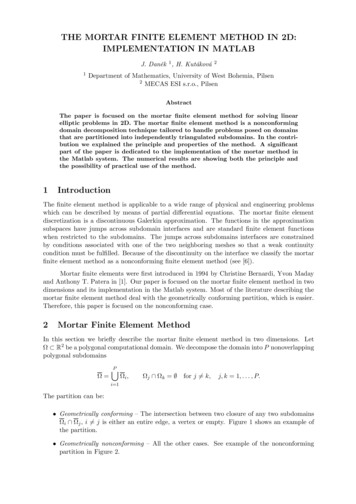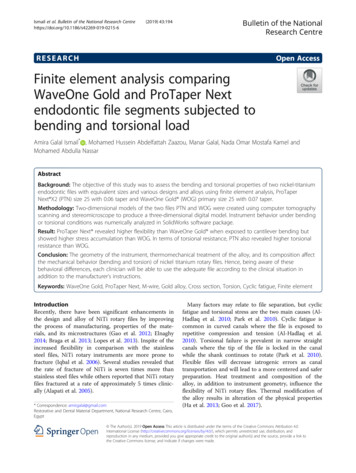
Transcription
Ismail et al. Bulletin of the National Research 19) 43:194Bulletin of the NationalResearch CentreRESEARCHOpen AccessFinite element analysis comparingWaveOne Gold and ProTaper Nextendodontic file segments subjected tobending and torsional loadAmira Galal Ismail* , Mohamed Hussein Abdelfattah Zaazou, Manar Galal, Nada Omar Mostafa Kamel andMohamed Abdulla NassarAbstractBackground: The objective of this study was to assess the bending and torsional properties of two nickel-titaniumendodontic files with equivalent sizes and various designs and alloys using finite element analysis, ProTaperNext X2 (PTN) size 25 with 0.06 taper and WaveOne Gold (WOG) primary size 25 with 0.07 taper.Methodology: Two-dimensional models of the two files PTN and WOG were created using computer tomographyscanning and stereomicroscope to produce a three-dimensional digital model. Instrument behavior under bendingor torsional conditions was numerically analyzed in SolidWorks software package.Result: ProTaper Next revealed higher flexibility than WaveOne Gold when exposed to cantilever bending butshowed higher stress accumulation than WOG. In terms of torsional resistance, PTN also revealed higher torsionalresistance than WOG.Conclusion: The geometry of the instrument, thermomechanical treatment of the alloy, and its composition affectthe mechanical behavior (bending and torsion) of nickel titanium rotary files. Hence, being aware of thesebehavioral differences, each clinician will be able to use the adequate file according to the clinical situation inaddition to the manufacturer’s instructions.Keywords: WaveOne Gold, ProTaper Next, M-wire, Gold alloy, Cross section, Torsion, Cyclic fatigue, Finite elementIntroductionRecently, there have been significant enhancements inthe design and alloy of NiTi rotary files by improvingthe process of manufacturing, properties of the materials, and its microstructures (Gao et al. 2012; Elnaghy2014; Braga et al. 2013; Lopes et al. 2013). Inspite of theincreased flexibility in comparison with the stainlesssteel files, NiTi rotary instruments are more prone tofracture (Iqbal et al. 2006). Several studies revealed thatthe rate of fracture of NiTi is seven times more thanstainless steel files while others reported that NiTi rotaryfiles fractured at a rate of approximately 5 times clinically (Alapati et al. 2005).* Correspondence: amirgalal@gmail.comRestorative and Dental Material Department, National Research Centre, Cairo,EgyptMany factors may relate to file separation, but cyclicfatigue and torsional stress are the two main causes (AlHadlaq et al. 2010; Park et al. 2010). Cyclic fatigue iscommon in curved canals where the file is exposed torepetitive compression and tension (Al-Hadlaq et al.2010). Torsional failure is prevalent in narrow straightcanals where the tip of the file is locked in the canalwhile the shank continues to rotate (Park et al. 2010).Flexible files will decrease iatrogenic errors as canaltransportation and will lead to a more centered and saferpreparation. Heat treatment and composition of thealloy, in addition to instrument geometry, influence theflexibility of NiTi rotary files. Thermal modification ofthe alloy results in alteration of the physical properties(Ha et al. 2013; Goo et al. 2017). The Author(s). 2019 Open Access This article is distributed under the terms of the Creative Commons Attribution 4.0International License (http://creativecommons.org/licenses/by/4.0/), which permits unrestricted use, distribution, andreproduction in any medium, provided you give appropriate credit to the original author(s) and the source, provide a link tothe Creative Commons license, and indicate if changes were made.
Ismail et al. Bulletin of the National Research Centre(2019) 43:194ProTaper Next ( Dentsply Sirona, Ballaigues, Switzerland)is made of M-wire premanufacturing heat treatment technology with a rectangular asymmetric cross section, variable taper and is run by a clockwise (CW) continuousrotation. M-wire has resulted in an increased resistance ofthe file to cyclic fatigue of up to 400% compared to otherfiles (Dentsply Maillefer n.d.; Topçuoğlu et al. 2017). Moreover, this asymmetric cross section improves canal shapingeffectiveness as assumed by manufacturer (Elnaghy 2014).WaveOne Gold (Dentsply Maillefer) when introducedwas claimed to have an increased elasticity owing to itsmetallurgical developments in gold-wire heat treatment.The gold process is a post-manufacturing procedure inwhich the ground NiTi files are heat-treated and slowlycooled. Its parallelogram-shaped cross-section has twocutting edges which are in contact with the canal wall,alternating with an off-centered cross section where onlyone cutting edge contacts the canal wall. It rotates in areciprocal motion, with preset values set by the manufacturer of clockwise/counter clockwise angles. Counterclockwise which is greater than the clockwise allows thefile to progress apically while the latter disengages thefile and eliminates file binding (Webber 2016; Adıgüzeland Capar 2017).Interpreting all the mechanical properties of those recent NiTi rotary files and how it affect their performancein the canal is very important in order to select the adequate file according to each clinical situation. Therefore, the aim of this study was to compare themechanical properties of the PTN files with WOG.Materials and methodsEndodontic instrument analyzedTwo NiTi instruments with similar cross-sectionalgeometry but different alloys were selected for thisstudy; PTN X2 (25, 0.06) variable taper with a rectangular cross section. It has a centered mass and axis of rotation from D1–D3 (diameter), whereas from D4–D16 hasan offset mass of rotation. Starting at 6%, the X2 file hasten increasing percentage tapers from D1–D11, whereasfrom D12–D16, there are decreasing percentage tapers.WOG Primary (25, 0.07) variable taper with a parallelogram cross section with two cutting edges in contactwith the canal wall, alternating with an off-centeredcross section. WOG has a fixed taper from D1–D3, yet a(a)(b)Fig. 2 3D model diagram. a ProTaper Next. b WaveOne GoldPage 2 of 6Fig. 1 Stereomicroscope imaging of WaveOne Goldprogressively decreasing percentage tapered design fromD4–D16, the primary file has diameters of 0.85 mm and1.0 mm at D9 and D12, respectively.Finite element analysisImage processingImage processing was done using computer tomographyand stereomicroscope scanning to obtain a 3D image.WaveOne Gold and ProTaper Next were both imagedat X5, X10, and X16 magnifications to obtain a detailedshape to obtain an accurate measurement of the files(Galal et al. 2015) (Fig. 1).Construction of 3D modelClassic modeling using CAD programs To build thefile’s model, the file cross section, rectangular for PTN,and parallelogram for WOG were drawn in 2D usingcomputer-aided design programs (CAD) (SolidWorkssoftware package). The 2D file with (.prt) extension wasconverted into Stereolithographic (.stl) extension to bereadable by programming software (MATLAB software)(Galal et al. 2015).3D modeling using MATLAB software Building of 3Dmodel in the form of sections was performed by MATLABsoftware using the following data: taper of the file, change in
Ismail et al. Bulletin of the National Research Centre(2019) 43:194(a)Page 3 of 6(b)Fig. 3 Cross-section design of the file’s 3D model diagram. a ProTaper Next. b WaveOne Goldpitch length, and cross-section changes (Galal et al. 2015)(Figs. 2a, b, 3a, b).Creation of finite element models Using CAD (SolidWorks software package), finite element (FE) models foreach file were created. The meshing of the models wasdone by (SolidWorks software package) using nonlinearstatic analysis type. The final FE model of PTN file consisted of 3236 elements with 5828 nodes, and for WOGconsisted of 4847 nodes and 2607 elements. For PTN,the maximum element size was 0.509905, while theminimum element size was 0.101981 mm, and for WOGthe maximum element size was 0.541989, while theminimum element size was 0.108398 mm. The stressstrain behavior was obtained from the literature and entered in the SolidWorks software package (Fig. 4a, b).(a)Mathematical analysis of FE modelsThe mathematical analysis of the two finite elementmodels was performed on SolidWorks software package.The mechanical behavior of the NiTi files was analyzednumerically in a SolidWorks package to simulate andmeasure bending and torsion (Galal et al. 2015).Application of bending Cantilever bending was simulated for the FE models by applying a constant load of 1N at the tip of the file with its shaft rigidly held in place.The vertical displacement was measured and the vonMises stress distribution was evaluated (Kim et al. 2009).Application of shear moment (torsion) Application ofa shear moment (torsion) 2.5 N/mm moment of forcewas applied to the shaft in a clockwise direction, whilethe last 4 mm of the tip was rigidly constrained. Thestress distribution was evaluated (Kim et al. 2009).ResultsBending resistance test(b)A maximum von Mises stress of 923 MPa appeared inthe ProTaper Next file with 11 mm displacement. Thehighest stress appeared near the middle one third of theshaft. A maximum von Mises stress of 846.5 MPa appeared in WaveOne Gold file. The highest stress appeared near the tip of shaft where the file was fixed anddecreased as it moved away from the supporting point(Table 1), (Fig. 5a, b).Table 1 Maximum Von Mises stress during bending resistancetest of different filesFig. 4 Meshing of 3D models. a ProTaper Next. b WaveOne GoldBending at 1 NWaveOne GoldProTaper NextDeflection (mm)8.04511Maximum stress (MPa)846.5923
Ismail et al. Bulletin of the National Research Centre(2019) 43:194Page 4 of 6Fig. 5 Finite element model of the stress distribution during bending. a ProTaper Next. b WaveOne GoldTorsion resistance testA maximum von Mises stress of 608 MPa appeared inthe ProTaper Next file. The highest stress appearednear the tip of the shaft and decreased towards the middle. A maximum von Mises stress of 1475 MPa appearedin WaveOne Gold file. The highest stress was limited tothe tip of shaft (Table 2) (Fig. 6a, b).DiscussionThis study assessed, compared, and analyzed the flexibility, torsion resistance, and stress distribution patterns ofPTN and WOG via finite element analysis. Finite element analysis (FEA) is a numerical procedure capable ofevaluating and assessing the mechanical behavior of theinstrument in addition to the stress distribution duringroot canal treatment. The value of FEA is a welldocumented procedure in endodontic research. In a virtual environment, the FEA method consists of modelinga structure with loads and boundaries to specify, analyze,and solve potential structural or performance issues. Insimulations of finite element analysis, a structure is idealized as many small, discrete segments known as finiteelements connected at nodes. The resulting models include salient features, such as materials, geometricalcharacteristics, boundary conditions, and loads in orderto reveal reality as close as possible (Kim et al. 2009;Wakabayashi et al. 2008).The main advantage of FEA simulation methods isthat different characteristics such as different alloys ordesigns can be nondestructively applied. The amount ofdeflection under cantilever bending is a measure of instrument flexibility. Flexibility of NiTi rotary instruments is a significant factor because it is responsible ofthe mechanical behavior and performance of files incurved canals (Ha et al. 2017).PTN revealed a greater deflection than WOG indicating that PTN possesses higher flexibility. Both PTN andWOG have an off-centered cross-sectional design whichreduces the screw in force and both are subjected toheat treatment (Ha et al. 2017).Fig. 6 Finite element model of the stress distribution during torsion. a ProTaper Next. b WaveOne Gold
Ismail et al. Bulletin of the National Research Centre(2019) 43:194Table 2 Maximum Von Mises stress during torsion resistancetest of different filesTorsional moment at 2.5 N/mmWaveOne GoldProTaper NextMaximum stress (MPa)1475608The M-wire NiTi from which PTN is manufactured isexposed to thermo-mechanical processing which resultsin increased flexibility, leading to a better access andpreparation of curved canals. M-wire contains austenitephase with little amounts of martensite and R-phase atbody temperature, hence M-wire maintains superelasticstate (Zupanc et al. 2018).The highest stress of PTN file appeared near the middle one third of the shaft, and this may be related to theincreasing taper which is 7% from 6–9 mm and then itdecreases to 6%.WOG incorporates a new NiTi alloy which has undergone a thermomechanical treatment. However, it is important to point out several other factors that wouldhave considerable influence on fatigue behavior andstress distribution of NiTi including cross-sectional areaand helical angle. WOG has a parallelogram cross section vs a rectangular cross-sectional design of PTN. According to the numerical values if FEA, PTN has asmaller area than WOG which renders it more flexible.Moreover, Siva et al. (Silva et al. 2016) found more machining defects in WOG compared to Reciproc uponSEM evaluation. These defects may negatively influencethe cyclic fatigue resistance. Highest stress of WOG filewas concentrated at the tip and decreased as it movedaway from the point of support. This may be due to thedecreasing taper of the file which 7% at the 1st 3 mmand decreases to 6%.WOG revealed slight less concentration of stress thanPTN. This was in accordance with Siva et al. which revealed that all gold heat-treated files revealed enhancedflexibility and fatigue resistance compared with M-wireinstruments (Silva et al. 2016).As reported by Ninan & Berzins, file size and torsionalresistance are directly related. Likewise, the greater taperinstruments reveal greater torque but less angle of rotation. Hence, comparison between instruments was donefrom this perspective (Ninan and Berzins 2013).WOG Primary and PTN both have a tip size of 25with a 0.07 and 0.06 taper, respectively, which is constant in the apical 3 mm of the instruments. Therefore, the greater apical taper of WOG led to highertorsional than the PTN regardless the thermal treatment of the alloy. Stress concentration in PTN wasconcentrated near the tip and along the middle thirddue to increased taper and in WOG stress concentration decreased away from the tip due to decrease intaper.Page 5 of 6ConclusionUnder the conditions of this experiment, ProTaper Nextrevealed both higher flexibility and torsional resistancethan WaveOne Gold which reflects that the behavior ofinstruments mechanically depends not only on the thermomechanical treatment of the alloy but also on otherfactors such as instrument design and taper.AbbreviationsCAD: Computer-aided design; CCW: Counter clockwise; CW: Clockwise;FE: Finite element; FEA: Finite element analysis; NiTi: Nickel titanium;PTN: ProTaper Next; WOG: WaveOne GoldAcknowledgementsNot applicable.Authors’ contributionsAGI wrote manuscript and analyzed the data. MHZ substansively revised thework. MG analyzed data and interpreted it. NO analyzed the data andinterpreted it. MAN performed the measurements. All authors read andapproved the final manuscript.Authors’ informationDr. Amira Galal is a graduate (2001) and postgraduate (Msc-2009, phD2015) of Cairo University, School of Oral and Dental Medicine. She iscurrently a Researcher of Endodontics at the National Research Centreand a part time Lecturer of Endodontics at Misr International University.Dr Amira is also an FDI speaker and has lectured extensively nationallyand internationally. Moreover, she has published articles in local andinternational Journals. Dr Amira operates at her own private practice “DrAmira Galal Dental Care” in New Cairo, Egypt.FundingFunded by the National Research Centre.Availability of data and materialsThe datasets used and/or analyzed during the current study are availablefrom the corresponding author on reasonable request. All data generated oranalyzed during this study are included in this published article.Ethics approval and consent to participateNot applicable.Consent for publicationNot applicable.Competing interestsThe authors declare that they have no competing interests.Received: 23 August 2019 Accepted: 18 October 2019ReferencesAdıgüzel M, Capar ID (2017) Comparison of cyclic fatigue resistance of WaveOne andWaveOne Gold small, primary, and large instruments. J Endod 43(4):623–627Alapati SB, Brantley WA, Svec TA, Powers JM, Nusstein JM, Daehn GS (2005) SEMobservations of nickel-titanium rotary endodontic instruments that fracturedduring clinical use. J Endod 31(1):40–43Al-Hadlaq SM, Aljarbou FA, Al Thumairy RI (2010) Evaluation of cyclic flexuralfatigue of M-wire nickel-titanium rotary instruments. J Endod 36:305–307Braga LC, Magalhaes RR, Nakagawa RK (2013) Physical and mechanical propertiesof twisted or ground nickel-titanium instruments. Int Endod J 46:458–465Dentsply Maillefer (n.d.). The ProTaper Next Brochure. Available at: 8/line 218x7727/product 218x9105/. Accessed 10 Jan 2014.Elnaghy AM (2014) Cyclic fatigue resistance of ProTaper Next nickel-titanium rotaryfiles. Int Endod J 6. https://doi.org/10.1111/iej.12244 [Epub ahead of print]
Ismail et al. Bulletin of the National Research Centre(2019) 43:194Galal M, Nassef T, Saber S, Zaazou M, El-Ashry S (2015) Stress distribution of threeNiTi rotary files under bending and torsional conditions using a finiteelement analysis. Ain Shams Med JGao Y, Gutmann JL, Wilkinson K (2012) Evaluation of the impact of raw materialson the fatigue and mechanical properties of ProFile Vortex rotaryinstruments. J Endod 38:398–401Goo HJ, Kwak SW, Ha JH, Pedullà E, Kim HC (2017) Mechanical properties ofvarious heat-resistance treated nickel-titanium rotary instruments. J. Endod43:1872–1877Ha JH, Kim SK, Cohenca N, Kim HC (2013) Effect of R-phase heat treatment ontorsional resistance and cyclic fatigue fracture. J Endod 39:389–393Ha J-H, Kwak SW, Versluis A, Lee C-J, Park S-H, Kim H-C (2017) The geometriceffect of an off-centered cross-section on nickel-titanium rotary instruments:a finite element analysis study. J Dent Sci 12(2):173–178Iqbal MK, Kohli MR, Kim JS (2006) A retrospective clinical study of incidence ofroot canal instrument separation in an endodontics graduate program: aPenn Endo database study. J Endod 32:1048–1052Kim TO, Cheung GSP, Lee JM, Kim BM, Hur B, Kim HC (2009) Stress distribution ofthree NiTi rotary files under bending and torsional conditions using amathematic analysis. Int Endod J 42:14–21Lopes HP, Gambarra-Soares T, Elias CN (2013) Comparison of the mechanicalproperties of rotary instruments made of conventional nickel-titanium wire,M-wire, or nickel-titanium alloy in R-phase. J Endod 39:516–520Ninan E, Berzins DW (2013) Torsion and bending properties of shape memoryand superelastic nickel-titanium rotary instruments. J Endod 39(1):101–104Park SY, Cheung GS, Yum J et al (2010) Dynamic torsional resistance of nickeltitanium rotary instruments. J Endod 36:1200–1204Silva EJNL, Tinoco JM, Tinoco EMB, Vieira VTL, Sassone LM, Lopes HP (2016)Bending resistance and cyclic fatigue life of a new single-file reciprocatinginstrument WaveOne Gold. Eur Endod J 1(1):4Topçuoğlu HS, Düzgün S, Akti A, Topçuoglu G (2017) Laboratory comparison ofcyclic fatigue of WaveOne Gold, Reciproc and WaveOne files in canals with adouble curve. Int Endod J 50:713–717Wakabayashi N, Ona M, Suzuki T, Igarashi Y (2008) Nonlinear finite element analyses:advances and challenges in dental applications. J Dent 36(7):463–471Webber J (2016) Shaping canal with confidence: WaveOne Gold single file, asystem. Int Dent Afr Ed 6(3):6–17Zupanc J, Vahdat-Pajouh N, Schäfer E (2018) New thermomechanically treatedNiTi alloys - a review. Int Endod J 51(10):1088–1103Publisher’s NoteSpringer Nature remains neutral with regard to jurisdictional claims inpublished maps and institutional affiliations.Page 6 of 6
the maximum element size was 0.541989, while the minimum element size was 0.108398 mm. The stress strain behavior was obtained from the literature and en-tered in the SolidWorks software package (Fig. 4a, b). Mathematical analysis of FE models The mathematical analysis of the two finite element models was performed on SolidWorks software package.
